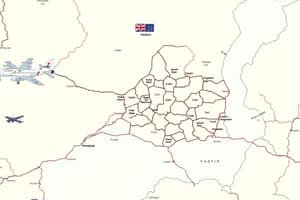Podcast
Questions and Answers
What is the primary purpose of submitting a Request for Forces?
What is the primary purpose of submitting a Request for Forces?
- To report operational failures
- To obtain personnel support for operations (correct)
- To request equipment upgrades
- To secure funding for future operations
The 152nd Theater IO Group will no longer be active as of FY 2017.
The 152nd Theater IO Group will no longer be active as of FY 2017.
True (A)
Name the three regional focus areas of the 56th Theater IO Group.
Name the three regional focus areas of the 56th Theater IO Group.
U.S. Pacific Command, U.S. Central Command, U.S. Northern Command
Soldier and leader engagements are __________ interactions with audiences in an area of operations.
Soldier and leader engagements are __________ interactions with audiences in an area of operations.
Match each Theater IO Group with its assigned component:
Match each Theater IO Group with its assigned component:
Which of the following is considered a potent Information Related Capability (IRC)?
Which of the following is considered a potent Information Related Capability (IRC)?
Individual Soldiers and Army civilians have no impact on mission accomplishment.
Individual Soldiers and Army civilians have no impact on mission accomplishment.
What is the role of Soldier and leader engagements in Information Operations?
What is the role of Soldier and leader engagements in Information Operations?
What is one responsibility of an IO officer in relation to unit operations?
What is one responsibility of an IO officer in relation to unit operations?
The IO officer is responsible only for coordinating anti-air operations.
The IO officer is responsible only for coordinating anti-air operations.
Name one type of information relevant to the intelligence preparation of the battlefield (IPB) that the IO officer assists in assessing.
Name one type of information relevant to the intelligence preparation of the battlefield (IPB) that the IO officer assists in assessing.
The IO officer provides information in support of _________ at the unit level.
The IO officer provides information in support of _________ at the unit level.
Match the following ISR elements with their corresponding descriptions:
Match the following ISR elements with their corresponding descriptions:
Which of the following best describes an Information Related Capability (IRC)?
Which of the following best describes an Information Related Capability (IRC)?
The IO officer only collaborates with the G-2 (S-2) regarding internal operational tasks.
The IO officer only collaborates with the G-2 (S-2) regarding internal operational tasks.
What role does the IO officer play in the development of the commander's narrative?
What role does the IO officer play in the development of the commander's narrative?
What is a primary responsibility of the IO officer?
What is a primary responsibility of the IO officer?
Commanders can adapt their staff structure to accomplish IO objectives.
Commanders can adapt their staff structure to accomplish IO objectives.
What is essential for the IO officer when working with IRC units?
What is essential for the IO officer when working with IRC units?
The IO officer must be ready to lead planning and employment of select IRCs not clearly managed by a __________.
The IO officer must be ready to lead planning and employment of select IRCs not clearly managed by a __________.
Which of the following is an example of an Information-Related Capability (IRC)?
Which of the following is an example of an Information-Related Capability (IRC)?
Why is synchronization of IRC activities important?
Why is synchronization of IRC activities important?
The effectiveness of messages and actions can be increased through variation and __________.
The effectiveness of messages and actions can be increased through variation and __________.
Match the following IRCs with their descriptions:
Match the following IRCs with their descriptions:
Flashcards
Requesting IO Group Support
Requesting IO Group Support
Process for requesting and approving Theater IO Group support.
56th Theater IO Group Focus
56th Theater IO Group Focus
The 56th Theater IO Group's focus areas include U.S. Pacific Command, U.S. Central Command, and U.S. Northern Command.
71st Theater IO Group Focus
71st Theater IO Group Focus
The 71st Theater IO Group's focus areas include U.S. Southern Command, U.S. Northern Command, and U.S. Africa Command.
151st Theater IO Group Focus
151st Theater IO Group Focus
Signup and view all the flashcards
152nd Theater IO Group Focus
152nd Theater IO Group Focus
Signup and view all the flashcards
IO's Primary Goal
IO's Primary Goal
Signup and view all the flashcards
Soldier and Leader Engagement
Soldier and Leader Engagement
Signup and view all the flashcards
IO Officer
IO Officer
Signup and view all the flashcards
Information Operations (IO)
Information Operations (IO)
Signup and view all the flashcards
Effective Soldier Engagement
Effective Soldier Engagement
Signup and view all the flashcards
Information-Related Capabilities (IRCs)
Information-Related Capabilities (IRCs)
Signup and view all the flashcards
Common Operational Picture (COP)
Common Operational Picture (COP)
Signup and view all the flashcards
Synchronization of IRCs
Synchronization of IRCs
Signup and view all the flashcards
Building Rapport with IRCs
Building Rapport with IRCs
Signup and view all the flashcards
Variation and Repetition of IO Actions
Variation and Repetition of IO Actions
Signup and view all the flashcards
IRCs in Military Structure
IRCs in Military Structure
Signup and view all the flashcards
Assessing IO Risk
Assessing IO Risk
Signup and view all the flashcards
Contributing to Synchronization Matrix
Contributing to Synchronization Matrix
Signup and view all the flashcards
Identifying IRC Gaps
Identifying IRC Gaps
Signup and view all the flashcards
Coordinating IRC Usage
Coordinating IRC Usage
Signup and view all the flashcards
Supporting Operation Security (OPSEC)
Supporting Operation Security (OPSEC)
Signup and view all the flashcards
Supporting Military Deception
Supporting Military Deception
Signup and view all the flashcards
Leading the IO Working Group
Leading the IO Working Group
Signup and view all the flashcards
Assessing IRC Effectiveness
Assessing IRC Effectiveness
Signup and view all the flashcards
Study Notes
Roles, Responsibilities, Relationships, and Organizations
- Every member (commander, staff, IO officer) contributes to information operations (IO).
- IO support units and augmenting IO units are essential for mission success.
- Commanders are responsible for understanding threats, shaping the information environment, and exploiting or defeating them.
- Commanders rely on staff and IO officers to plan, execute, and assess IO.
- Commanders personally review information environment analysis, issue guidance on integrated response capabilities (IRCs), and direct adjustments.
- Every operation affects the information environment.
- IO planning is integral to operations from the start.
- Combat power optimization requires IO.
- Warfighting functions (movement, maneuver) produce information environment effects, intentional or otherwise.
- IO is vital for operational success at all levels, whether or not there is an assigned IO officer.
- All communication can have global, strategic consequences.
- Implementing IRCS has lead times and lag times.
- Alignment of words, deeds, and images is essential for trust.
- Prioritized intelligence support is necessary for IO.
- Information environment effects are not always predictable, and assessment is often difficult.
- U.S. IO operations are constrained by policy and law.
Staff Roles and Collaborations
- Staff sections collaborate with the IO officer for planning, synchronizing, supporting, and assessing IO.
- Representatives from G-2 (intelligence), G-3 (operations), G-5 (plans), G-6 (signal), G-9 (civil affairs) are core members of the IO working group.
Assistant Chief of Staff Roles
- G-1 (Personnel): designator of IO representatives, IO-focused instructions, and reviewing personnel support considerations.
- G-2 (Intelligence): part of the IO working group, provides intelligence briefings, IO-focused instructions, handles information requests, and coordinates with counterintelligence.
- G-3 (Operations): primary IO staff functions, integrates IO planning into the military decision-making process, and validates IO inputs, actions, and outputs.
- G-4 (Logistics): ensures IO resources, coordinates sustainment, and tracks operational readiness.
- G-5 (Plans): ensures IO affects future plans, collaborates with the IO officer, and incorporates IO objectives into plans and operations orders.
- G-6 (Signal): coordinates information management, provides representation to the IO working group, and provides training and resources.
- G-9 (Civil Affairs): provides representation to the IO working group, handles civil considerations, and provides IO-focused instruction.
IO Officer Responsibilities (focal point)
- Analyzes the information environment to determine effects, and to exploit opportunities.
- Identifies the most effective IRCS.
- Synchronizes IRCS.
- Assesses risk to mission and force.
- Provides input to IRC synchronization matrices.
- Identifies IRC capability gaps.
- Coordinates with other forces (Army, Service, joint) to address IRC capability shortfalls.
- Supports operation security (OPSEC).
- Supports military deception.
- Leads the IO working group.
- Assesses IRC effectiveness.
Information Operations Support Units (IO Support)
- The G-3 supports the integration of external IRCs.
- This includes the 1st Information Operations Command (Land), and reserve component theater information operations groups, which provide expertise, skills augmentation, and reachback
- These support units work with the IO officer.
Supporting Roles and Teams
-
Vulnerability Assessment Team: identifies and resolves IO vulnerabilities.
-
OPSEC Support Team: provides OPSEC training.
-
Web OPSEC Support Team: manages web-based OPSEC.
-
Field Support Team: provides IO subject matter expertise.
-
Military Deception Support Detachment: plans, coordinates, executes, and assesses military deception.
-
Reachback Teams: provide IO support, especially for deployed units.
-
Theater Information Operations Groups: teams are important for IO planning, synchronization, and assessment across different Army echelons.
-
Soldier & Leaders: essential to influencing adversaries, and foreign audiences.
General Information
- IO objectives and IRC tasks may be performed by non-commissioned officers where necessary if there is no IO officer. Such assignments would still be conducted according to established protocols.
Studying That Suits You
Use AI to generate personalized quizzes and flashcards to suit your learning preferences.



